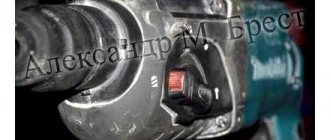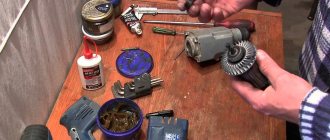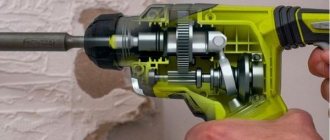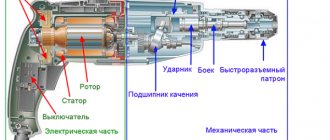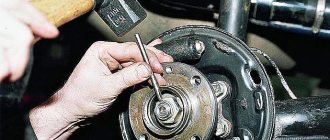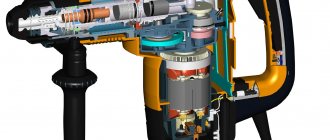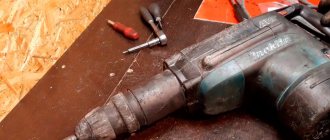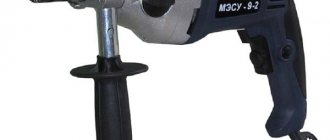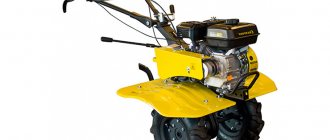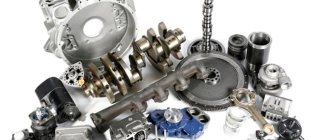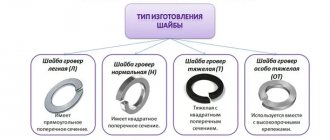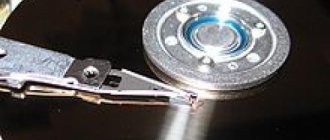In the vast majority of cases, breakdowns of hand tools occur at an extremely inopportune moment, so the question of what to do if a Stanley, Bosch, Maktec or other brand of hammer drill stops working is relevant for many home craftsmen and professionals.
A hammer drill is a technically complex device. In principle, all its breakdowns, the list of which is quite large, are divided into electrical and mechanical. The most common causes of malfunction of a Makita, Interskol, Dewalt, etc. rotary hammer:
- wear caused by the duration of operation or the ingress of mechanical fractions;
- falling of the instrument, leading to damage to the housing;
- short circuit of the winding, wear of the brushes, burnout of the commutator lamellas;
- failure of bearings, gears, cartridge, safety clutch.
Diagnostics of rotary hammer faults
If, during operation, problems with the operation of the hammer drill become obvious, you should disconnect it from the power supply and carry out an external inspection.
If external signs of failure are not found, you will have to disassemble the case and look for the problem inside. One of the reasons for device failure is a break in the power cord. In this case, the rotary hammer motor does not turn on. To diagnose it, you need to carefully inspect the cable connecting the tool to the network. It must not be damaged, broken or melted. A working power cord remains cool during operation. If the wire is not in order, it should be replaced with an equivalent one. The cross-section of the conductive elements must correspond to the power consumed by the tool.
Universal diagnostic tool for electrical circuits
Conventionally, all hammer drill malfunctions can be divided into two categories - mechanical and electrical.
The mechanical category of malfunctions includes malfunctions that occur while the engine is running:
- the drill does not chisel;
- the drill does not rotate;
- the crown cannot be pulled out of the barrel (jammed);
- the chisel does not stay in the chuck (it pops out);
- extraneous sounds are heard inside the mechanism, grinding, vibration.
Electrical faults: the motor does not rotate, the brushes on the commutator spark and other types of breakdowns
The following signs indicate problems with the electrical part of the hammer drill:
- the motor does not rotate when turned on;
- the brushes on the commutator spark intensely;
- the smell of burnt insulation emanates from the body;
- Acrid smoke comes out of the tool during operation.
In order to find out and eliminate the cause of all these phenomena, the hammer drill must be disassembled.
Troubleshooting
As noted, some problems can be identified immediately. The main thing is to understand in which part of the hammer drill the problem has arisen.
If you smell a burning smell, the tool is noisy or heats up quickly, there is a grinding noise, or there is already smoke, then these are signs that your repair tool is not working properly.
If you understand that the problem is in the electrical part, then be careful. Check that the hammer drill is de-energized , otherwise repairing such a tool is dangerous not only for it, but also for your health.
When the rotary hammer refuses to turn on, the failure is electrical and you should check if the wires are broken . In this case, first determine where exactly the wire is broken, then replace it or shorten it at the break point.
If you load the hammer too much, the damping mechanism may burn out . Then you will have to replace all burnt parts.
To prevent this, take breaks from work. For example, stop the device after every 20 minutes of continuous operation.
If something sparkles inside, then most likely the problem is in the brushes . They either do not fit tightly to the anchor, or moisture got there and they began to oxidize. Then the optimal solution would be to replace them .
If water has already gotten onto the anchor, then you will have to carefully dry everything, but so as not to also spoil the winding. To do this, use a cotton swab and alcohol.
Replacement of main parts
When using the device, you must ensure that it is in good working order. When the first signs of a malfunction appear, urgent repairs are necessary. In order to avoid serious repairs, you need to monitor the condition and, if necessary, change the following elements: bearings, power button, graphite brushes and cartridge.
The bearing is replaced if lubricant has leaked from it, it turns hard or creaks. To perform this operation you will need a puller and a wooden hammer.
The power button is very easy to change. This requires disassembling the case. In this case, it is necessary to ensure that the device is disconnected from the network.
In order for the equipment to serve for many years, it is necessary to perform maintenance, keep it clean, regularly clean and lubricate moving parts and replace brushes and bearings. In this case, repairs may not be necessary at all; the equipment will serve properly for many years.
The drilling part is stuck in the chuck
Sometimes you don’t need to disassemble a hammer drill to understand why it doesn’t hit. It happens that the drill gets stuck in the chuck.
Drill jamming
This is due to the following reasons:
- When installing the drill into the chuck, no lubricant was applied to the shank. It is necessary to carefully move the rubber seal on the cartridge and add WD-40 to the joint.
- The shank broke. In this case, you need to first inject WD-40, and only then try to remove the drill. If this does not work, you should disassemble the cartridge and knock out the drill.
- The role of the drill is played by a drill with an adapter. Here, too, the joint area is treated with WD-40 first. After a few minutes, you can begin to lightly tap the chuck with a hammer, systematically loosening the drill with your other hand. After this, the clamping jaws of the chuck should unclench.
Repair procedure
In order to repair the equipment, it must be disassembled. To do this, you need the following equipment: wrenches, screwdrivers, vices and bearing pullers. When lubricating mechanical parts, you will need a rag and solvent.
To repair the electrical part of the hammer drill, you may need winding diagrams and wires.
To disassemble the device, you must first remove the cartridge. After this, the body opens. If necessary, you can open only the part with the engine or the compartment with the gearbox. To repair faulty parts of a rotary hammer, you should first study photographs of such work.
Let's look at the most common equipment malfunctions, the procedure for inspecting and repairing rotary hammer problems.
How to disassemble a hammer drill
Disassemble the hammer drill sequentially. Inspect all details carefully. Even if you are looking for a problem in one unit, you may find damaged parts in other units. When disassembling the tool, the body should be cleaned of dust and dirty grease.
How to disassemble a cartridge and remove stuck equipment
Start by disassembling the cartridge so that it does not interfere with the removal of the gearbox housing.
- Remove rubber boot 1, retaining ring 2 and plastic boot 3.
- Next, be careful, as there is a ball in the grooves of the sleeve under the fixing washer 4. He might jump out.
- Carefully remove washer 4, locking plate 5, spring 6 and ball 7. Depending on the chuck model, there may also be rings, washers and balls.
If a drill or other equipment cannot be pulled out of the chuck, there are two options for solving this problem:
- Clamp the tool in a vice. Slightly shake the hammer drill and pull it towards you;
- Clamp the hammer drill in a vice through the rubber gaskets so as not to damage the plastic housing. Clamp the end of the equipment with a gas wrench. Tap the key with a hammer in the direction of the axis of the tool.
The second option is used as a last resort. If after several blows the drill or chisel cannot be pulled out, stop. You may damage the hammer drill. Disassemble the cartridge and gearbox. Try to knock out the equipment with a drift. After this procedure, the raster sleeve will most likely need to be replaced. To avoid this problem in the future, lubricate the end of the equipment.
How to remove the mode switch
In some models of hammer drills, the switch is removed by turning it to the extreme right, in others - to the extreme left. Consider the extreme right position.
- Set the mode switch to strike. If there is no impact mode, use drilling impact.
- Press the button in the switch and turn it just below the stroke until it clicks.
- Pull it towards you, pry it with a screwdriver and remove it.
Disassembly of the electrical part of the hammer drill
- Unscrew and remove the back cover.
- Unscrew the bolts securing the power cord.
- Remove the button and wires from their grooves.
- Disconnect the wires from the stator.
- Unscrew the brush holder bolts and remove the brushes.
- Clean the housing from dust.
- Unscrew the bolts connecting the electrical housing to the gearbox housing. Separate both housings with a screwdriver.
- The rotor is connected to the gearbox through a shaft and can be easily removed from it. Remove the bearings from the armature using a puller.
- Remove the air intake from the electrical housing.
- Unscrew the stator from the housing. Take a piece of wood and knock gently on the ribs of the housing, and the stator will begin to come out.
Mechanical malfunctions of makita 2450 and makita 2470 rotary hammers
Common mechanical malfunctions of Makita rotary hammers include:
- destruction of the quick release chuck;
- bearing failure;
- damage to the impact mechanism;
- wear of the hammer drill barrel;
- wear of the rubber striker and striker;
- gear failure.
Repair of a hammer drill chuck is carried out to replace the boot and rubber ring, as well as a conical spring and a steel ball that clamps the working tool (drill). This is indicated by the fact that the working tool? namely the drill, is poorly held in the chuck.
The main reason is wear of the steel ball 7.0 pos. 20, art. 216022-2. Ball wear occurs from contamination of the cartridge bore due to dust and dirt getting inside.
The general view and design of the Makita hammer drill chuck is shown in the photo below.
Repairing a makita 2450 hammer drill chuck with your own hands is easy. The cartridge must be disassembled, freed from old grease, discarded rubber parts, and replaced defective ones.
More complex faults require knowledge of the mechanical structure of the Makita 2450 rotary hammer.
Having determined the nature of the malfunction of the Makita rotary hammer, proceed to disassembling the mechanical part, called the gearbox.
Disassemble the mechanical part according to the attached video. Free it from old grease. Carefully inspect all parts, their integrity, and level of wear. All rubber products require replacement during any disassembly.
Let's consider repairing a hammer drill barrel. Let's analyze the mechanism completely. Video of disassembling, lubricating and assembling a Makita hammer drill
Repair of parts of the Makita 2450 hammer drill barrel
Remember! The rotor is held in the lower part of the housing by electric brushes, which must be removed.
At the next stage, the rotor must be disconnected from the removed mechanism. The rotor is detached from the mechanism simply by pulling it out, since it is held in place by the friction of two helical gears.
It turned out to be such a dirty knot.
Now we need to separate the impact mechanism shaft.
Most often, the rubber rings and the firing pin, pos. 24, compressor spring pos. 18. and cylinder parts. This is how barrel parts wear out and break down when the tool is used incorrectly.
Let's consider the most complex malfunction - failure of the impact mechanism. Characteristic signs of failure of the impact mechanism are the absence of impact and the unpleasant noise of the rotary hammer operating in the “Impact” mode.
This malfunction is typical for those rotary hammers that, during operation, were strongly pressed against the surface being processed. Having disassembled the gearbox, we remove debris and pieces of foreign objects. We find the faulty part and clean everything of old grease.
Very often the firing pin, item 24, art. 324396-8, included in the barrel. metal ring pos. 27. art. 324216-6.
Discard damaged parts, replace with new ones, and cover with a thin layer of lubricant. The parts are ready for assembly. But more on that in the next article.
Due to the ingress of dust, dirt, and moisture, the internal lubricant becomes hard over time and does not fulfill its purpose. The hammer drill starts to make extraneous noise. When starting to repair a rotary hammer, be sure to read the attached instructions for disassembling, lubricating, and assembling components of the Makita 2450, 2470 rotary hammer. The diagram of the Makita 2450 and 2470 rotary hammer will help you correctly disassemble faulty components and find defective parts. We will also tell you how to disassemble the Makita 2450 rotary hammer.
What malfunctions do Bosch rotary hammers have and how to fix them yourself
Nothing lasts forever. And the most reliable Bosch rotary hammers begin to break over time. But any malfunction can be repaired with your own hands if you have detailed instructions for performing repair work. Below we offer you a guide to troubleshooting Bosch rotary hammers and a method for eliminating them. The main causes of breakdowns are:
- careless work with the tool;
- improper storage of the hammer drill;
- heavy loads when working on working parts when chiseling or drilling;
- tool overheating;
- long work without a break;
- failure to comply with maintenance schedules.
Conventionally, faults can be divided into mechanical and electrical.
Next, we will consider faults according to their affiliation, dividing them into mechanical and electrical faults.
Mechanical malfunctions of the Bosch rotary hammer
When mechanical malfunctions occur in the operation of the tool, an extraneous unpleasant sound appears, sparking intensifies in the collector area, a burning smell appears, the tool heats up excessively, its power drops depending on the duration of operation and the impact on the material.
We will look at all the faults in the diagram of the Bosch 2-26 rotary hammer. Other models, such as Bosch 2-20, 2-24, differ in the design of the intermediate shaft and the installation of various bearings.
The hammer drill stops hammering, but drills
The hammer drill does not hammer under load or in idle mode for the following reasons:
- the rubber rings of the striker, striker, and piston are worn out;
- the rolling bearing race has collapsed;
- the cylinder and the firing pin of the percussion mechanism were destroyed;
- cut off the splines of the clutch mounted on the intermediate shaft;
The hammer drill has stopped drilling, but is chiseling
The main reasons why a rotary hammer hammers but does not drill are:
- the force of the conical spring pressing the clutch has weakened;
- the locking roller does not fix the large barrel shaft gear;
- does not hold the tool locking mechanism in the barrel;
- The hammer drill does not chisel or drill.
The main reasons why a hammer drill does not chisel or drill are:
- sheared teeth on the small rotor gear or on the large intermediate shaft gear;
- The rotary hammer electric motor does not work;
- there is no power to the hammer drill motor.
Now let's talk about everything in order
Let's consider options in which the hammer drill does not hammer, but drills
Wear of rubber rings on the striker, striker, piston.
This reason appears gradually as the rubber rings wear out. At first the blow weakens, then disappears altogether.
https://www.youtube.com/watch?v=2YMh_0ldTlw
The malfunction is eliminated by replacing the indicated rubber rings with new ones.
For any repair of rotary hammers or their components, all rubber products must be replaced.
Repair kit for rubber sealing rings for a Bosch 2-26 rotary hammer
The rolling bearing race has fallen apart (drunk bearing)
If the drunk bearing pos. 830 is destroyed, the rotational movement of the intermediate shaft cannot be converted into the translational movement of the cylinder in the impact mechanism.
Eliminated by completely replacing the rolling bearing.
Friction bearing
The cylinder, firing pin, and firing pin of the firing mechanism were destroyed
There are cases when the striker in the cylinder, pos. 26, gets stuck, which leads to destruction of the cylinder and the impossibility of creating air pressure in the barrel of the striker mechanism. And the second reason: destruction or breakage of the striker pos. 28, leading to distortion of the part and the impossibility of transmitting the shock impulse. Breakdowns are eliminated by completely replacing failed parts.
The firing pin is jammed in the piston, the piston is destroyed
The splines of the clutch, pos. 67, mounted on the intermediate shaft, were cut off
The malfunction can be eliminated by repairing the clutch or completely replacing it. When making repairs, the worn teeth on the clutch are filed down. To correct this defect, a round needle file and a drill are used. The coupling is clamped in the hand, and the tooth profiles are straightened using a drill with an appropriate file. The splines on the intermediate shaft are modified in the same way.
Restoring the teeth of the intermediate shaft clutch
The force of the conical spring pressing the clutch has weakened
When the pressure force of the spring pos. 50 decreases, the clutch slips on the intermediate shaft without transmitting rotation from the small spur gear to the large gear pos. 22 of the barrel shaft pos. 821 of the impact mechanism. By the way, on different Bosch models, clutches are designed differently.
Details of the torque and translational impulse transmission unit
The locking roller does not lock the large barrel shaft gear
The large gear, pos. 22, is attached to the barrel shaft, pos. 01, with a roller, pos. 88, pressed against the shaft collar with a conical spring, pos. 80, and secured with a retaining ring, pos. 85.
The reason may be a weakening of the force of the conical spring pos. 80, destruction of the locking ring pos. 85, or loss of the fixing roller pos. 88.
Gear pos.22 on the shaft pos.01 of the barrel pos.821 of the shock block assembly
The mechanism for fixing the tool in the drill barrel does not hold the drill
Bosch rotary hammers use two types of chucks: SDS-plus and SDS-max. The difference is in the design of the locking mechanism.
The reason is the wear of the antennae of the chuck raster bushing, which makes it impossible to transmit the shock pulse to the working tool of the hammer drill.
Tool shanks for hammer drill chucks Bosch 2-26
Sheared teeth on the small rotor gear
The gears rotate and the teeth on one of them, usually the small one, are cut off.
When the working tool jams and the clutch does not work properly, the gear teeth on the hammer drill shaft and the intermediate shaft wear out or are completely destroyed.
In this case, the rotor or large gear of the intermediate shaft is completely changed.
Bosch 2-26 hammer drill rotor with cut splines
Hammer drill motor does not work
The reasons for a non-working electric motor may be:
- short circuit in the rotor, stator;
- destruction of carbon electric brushes;
- loosening of the brush holders;
- burnout of lamellas on the rotor commutator;
- breakage of the rotor or stator windings.
The listed malfunctions are eliminated by repair (manually rewinding the windings, replacing the commutator and desoldering the winding leads) or replacing the rotor, stator, and carbon electric brushes with new ones. The majority of malfunctions in the electrical part of the Bosch 2-26 rotary hammer are confirmed by increasing sparking in the collector area.
The length of serviceable electric brushes cannot be less than 8 mm. When replacing one brush, the second should change automatically.
The rotor or stator windings can be rewound yourself at home.
Burnt rotor manifold of a Bosch rotary hammer
No power to the electric motor of the Bosch rotary hammer
The cause of this malfunction is a break in the wire supplying power to the electric motor. Most often, a break occurs at the point where the cable enters the hammer drill. The wire should be replaced with a new one or repaired.
The malfunction can be determined using a tester. If there is no tester, the fault can be found using the power phase and a screwdriver with a neon indicator lamp.
Connecting the power wires one by one, at the other end, using a neon screwdriver, determine the presence or absence of a phase.
The power button for the hammer drill does not work. Determined by a short circuit tester.
Most often, the failure of the punch button is caused by a short circuit of the filter capacitor. It is best to replace the button with a new one.
Power cord pos. 5 at the entrance to the tool
General electrical faults of the Bosch 2-26 rotary hammer
Failure of a rotary hammer in the electrical part is accompanied by the appearance of a burning smell, strong heating of the tool during operation, the appearance of large sparks in the area of the rotor commutator of the rotary hammer, and poor operation of the reverse switch.
The operation of the hammer drill is influenced by the condition of the carbon brushes, the reliability of the fastening of the brush holders and their correct installation.
A burning smell appears when the stator or rotor windings are short-circuited.
A drop in power of a rotary hammer with increasing load is typical when there is a break in the rotor windings or when the carbon brushes are short.
The heating of the hammer most often results from a short interturn circuit in the stator or rotor.
Large sparking in the commutator area is caused by interturn closure of the rotor or burnout of the commutator lamellas.
Malfunction of the reverse switch occurs due to burning of its contacts.
But the main reason for all breakdowns is untimely implementation of technical routine maintenance and replacement of carbon brushes.
Carbon brushes require replacement after 70 hours of operation or when worn down to 8 mm in length.
General view and dimensions of the carbon brushes of the Bosch rotary hammer
We have given the main reasons why Bosch rotary hammers fail. We may not have described all the breakdowns of Bosch rotary hammers.
If you know other faults with Bosch 2-20, 2-24, 2-26 rotary hammers, please share with us.
I wish you success!
replacing the raster bushing in a Bosch 2-26 chuck; replacing an armature in a Bosch 2-26 rotary hammer
Source: https://sdelalremont.ru/xarakternye-neispravnosti-v-perforatorax-bosch-i-sposoby-ix-ustraneniya.html
Repairing a screwdriver step by step
We take out the engine and carefully disconnect the motor and gearbox. Let's disassemble the gearbox itself. To assemble it exactly as it was, you need to photograph it or schematically sketch the location of the gearbox. If the teeth of the coupling are worn out, then replace it with a new one
It must be firmly fixed.
We carry out repairs using a bench vice, drill and drill of the required size. You will also need wire cutters and some screws.
The repair process will not take much of your time and attention. If you still decide to repair the worn teeth of the old coupling rather than buy a new one, then you will need a drill and a drill bit. To do this, you just need to drill several holes in the places where the teeth were and screw the required number of screws into these holes.
If parts of the screws protrude, then shorten them using wire cutters and turn on the screwdriver to check the functionality of the tool.
Below in the video you can visually watch the repair process itself.
Preventive measures
It is better to prevent breakdown, so it is better to adhere to the following recommendations.
- Change the lubricant twice a year.
- Every six months, preventive inspection of brushes.
- Thorough cleaning every time after work.
- Before work, lubricate the back of the drill or chisel to reduce the load on the striker.
If the hammer drill stops working normally or breaks down, read the instructions and inspect it carefully. Before you start making repairs yourself, really evaluate your capabilities. If you are sure, try to fix it yourself, otherwise, if in doubt, it is better to contact a specialist. And remember that already repaired mechanisms are not subject to warranty and service centers are reluctant to accept them for repairs.
Source
Possible malfunctions, causes of their occurrence and solutions
To repair a rotary hammer with your own hands, you must first determine the external manifestations of malfunctions.
The hammer drill does not hit
If the hammer stops hitting when switching to impact mode, but the drill rotates, it is most likely that the floating bearing is damaged. The solution to the problem is to replace it with a new one.
The second possible reason is a malfunction of the striking mechanism. Often, when overloaded in work, the steel striker splits, this leads first to a weakening of the impact, and then to its complete absence. The firing pin needs to be replaced.
The third probable reason is wear or breakage of the piston group of the hammer drill. The liner and piston should be replaced.
The hammer drill does not spin and does not drill
If the chuck does not rotate when you press the start button in drilling mode, the cause can first be determined by the sound. If the electric motor hums but does not turn the chuck, most likely something is preventing the rotor from rotating inside the gearbox. What happened to the engine will have to be found out by disassembling the mechanical part of the tool.
If the engine does not hum when turned on, it is more likely that the motor has failed. Having opened the lid of the device, it is necessary to determine what exactly led to this phenomenon. This could be an open circuit, a broken start button, or a short circuit in the coil windings. Using the tester, the specific cause is determined and appropriate repairs are made.
The drill does not stay in the chuck and flies out
Incontinence of the hammer drill equipment can occur during long-term use. The drill or chisel inserted into the chuck does not hold and flies out during operation. It is not only impossible to continue chiseling with such a tool, it is also very dangerous - a flying chisel can cause injury.
The reason for equipment incontinence lies in wear or breakage of the cartridge. The cartridge needs to be disassembled and determined what the problem is. Perhaps the balls have become deformed, wear has appeared on the restrictor ring, or the retaining spring has sagged. Usually, after replacing the damaged part, the cartridge begins to function normally again.
Video: why drills fly out of a hammer drill
The brushes sparkle
Sparking brushes is a fairly common phenomenon when working with tools in dusty conditions. As a rule, sparking is a consequence of the deterioration of the material of the brushes themselves. Replacing the latter with new ones will help correct the situation; sparks will no longer fly out.
If not, the reason must be sought in the stator or rotor windings. It is possible that the large amount of dust entering the motor has caused the protective varnish covering the copper conductors to wear away. And this entails a short circuit. The presence of an interturn short circuit is checked using electrical instruments (multimeter).
The resistance between the lamellas is measured with a multimeter
In addition, it should be taken into account that dust may adhere to the lubricant of the bearing located next to the commutator. To prevent this, the collector is degreased using a swab soaked in alcohol or solvent.
The hammer drill gets very hot
If the hammer drill gets excessively hot during operation, this is a clear sign of a malfunction of the electric motor. First of all, to prevent overheating, you must observe the operating mode of the device:
- take breaks at certain intervals;
- After loading, give the tool the opportunity to idle.
When drilling, it is recommended to use a periodic mode: apply maximum power for no more than 1 minute, then turn on idle for 3-4 seconds.
If the housing temperature does not decrease, then you need to inspect the electric motor. If you notice a characteristic odor coming from under the tool casing, you must immediately stop working and disconnect the device from the network. You can disassemble it only after it has completely cooled down.
The hammer drill does not hold the chuck
Sometimes there is a situation when the cartridge flies off along with the equipment while the hammer drill is running. This occurs due to wear of the chuck body mount at the end of the raster sleeve, which is a retaining ring. If it breaks, the fixation is broken and during the push the rubber boot flies off, followed by the spring and balls.
You can restore normal operation of the cartridge by installing a new locking ring. This is done quickly and does not require any additional equipment other than a regular screwdriver.
Rotary hammer design, assembly diagram and spare parts list
The tool consists of a single-phase motor and rotor. A gear located on the armature shaft is responsible for rotational movements. Between them there are bearings, one of which is “drunk”, it is this that transmits movement to the working parts.
Barrel hammer drill repair
This procedure is no different from repairing a conventional hammer drill. It is worth considering that the motor and shaft are located vertically.
How to fix a rotary hammer with your own hands
The repair procedure at home is the optimal solution and will cost less than the services of service centers. Instrument repair is expensive and it is not a fact that you will find a conscientious repairman. Before you think about how to make a hammer drill, you should acquire the necessary tools and stock up on theoretical knowledge on how to disassemble and assemble a hammer drill. After completing the repair, run it in gentle mode.
Hammer hammer impact mechanism
Most modern rotary hammers have an electro-pneumatic impact mechanism. “Electric” means that the mechanics are driven by an electric motor, and “pneumatic” means that the striker hitting the drill shank is driven by air.
- Engine rotation transmission gear
- "Drunk" bearing
- Piston
- Drummer (“flying piston”)
- Trunk
- Striker
- SDS cartridge
When you press the button, the engine transmits rotation to a shaft with a “drunk” bearing, which in turn drives the piston inside the barrel. As the piston moves forward, air pressure increases between it and the striker. The striker moves towards the striker and hits it. The striker transfers the impact energy to the drill. Then the piston moves in the opposite direction, creating a vacuum area in the barrel. Due to this, the striker returns to its original position, after which the entire cycle is repeated.
Most rotary hammers have two or three operating modes:
- combined mode: impact and rotation of the drill;
- Rotation lock mode: only the impact mechanism works;
- impact blocking mode: the hammer drill
can be used as a drill or a mixer for preparing building mixtures.
How to remove the mode switch
To diagnose internal components, it is necessary to remove the hammer housing and clean the surface of the components from dust. The analysis begins with the compartment of the operating mode regulator.
It is moved all the way - as a rule, this is the extreme right position (below the rebound mode icon), after which, using a flat screwdriver, the regulator is removed from its socket.
Mode switch
Mechanism parts may come out of the guide grooves. This may be a consequence of deformation, wear, or frequent use of the tool with the mode not fully engaged. The malfunction is eliminated by installing the parts in their places or replacing them with new ones.
Bosch GBH 2 26 DFR (Rotary hammer, electrical part)
If the power tool does not begin to peel, you can limit yourself to disassembling the spindle assembly in this order:
- dismantling the mode switch lever - the parts are usually made of polymers and therefore are quite fragile;
- detachment of the boot - the rubber corrugation must be replaced from time to time, as it often comes into contact with destructible materials, wears out, and cracks;
- with a dismountable cartridge, the brushes are first removed; screws are loosened and unscrewed;
- the body is divided into two halves.
Visual inspection in 90% of cases allows you to identify a malfunction and replace the warped/worn part. Before assembly, lubricant is immediately added and replaced.
Source
Reasons for the lack of impact
At first glance, it seems that the impact mechanism has a simple design and there is nothing to break. Load, dust and vibration gradually take their toll. Typically, the impact force decreases as the mechanism wears out and eventually disappears. The sudden disappearance of the impact is explained by the deformation or destruction of some parts.
Striker and striker
These parts are made of high-strength steel. The firing pin rarely fails, but the bushing in which it moves absorbs some of the impact energy and breaks down over time. The fragments jam the firing pin and the hammer stops hitting.
The firing pin (“flying piston”) has a compression ring. When it wears out, part of the air passes into the gap between the cylinder in the barrel and the firing pin. The more wear, the weaker the impact. The problem is solved by replacing the ring with a new one.
Sometimes the striking part of the “flying piston” breaks on the firing pin. This is usually the result of pressure on the hammer when drilling holes. The drilling speed does not increase, but the load on the mechanism increases, which accelerates wear. Repair consists of chamfering on an emery machine or replacing a part.
"Drunk" bearing
It is mounted on the shaft at an angle and drives the piston. If there is wear or damage, the bearing must be replaced.
Mode switch
Mechanism parts may come out of the guide grooves. This may be a consequence of deformation, wear, or frequent use of the tool with the mode not fully engaged. The malfunction is eliminated by installing the parts in their places or replacing them with new ones.
Lubrication
Untimely replacement of lubricant can also be the reason for the lack of shock. Working with a hammer drill involves the presence of dust, which does not have the best effect on the properties of lubricants. Dust can clog the holes in the cylinder that allow air to circulate when the impact mechanism operates. The same effect cannot be ruled out when using too thick a lubricant not intended for hammer drills.
The main reasons why a hammer drill sparks
- Incorrect installation
- Worn condition
- Incorrect installation of brush holders
- Poor fit to the manifold
- Pressing parts too hard
- Using components that are not the same brand as the tool.
In any case, for the above reasons, you should disassemble the device and inspect the components.
Replacing brushes
If it’s time to change the brushes in your hammer drill, you can take the tool to a service center for this task, or you can replace them with your own hands.
Service at a service center has a number of advantages:
- High-quality work, if you contact a specialized center
- Original components - for your tool model
- Extending the warranty if the period has not yet expired
- In addition to replacing the broken part, the service usually inspects the entire internal important parts, cleans them and lubricates them
How to repair the cartridge and impact mechanism of the barrel of a makita 2470 hammer drill
Due to the ingress of dust, dirt and moisture, the internal lubricant becomes hard over time and does not fulfill its purpose. The hammer drill starts to work with extraneous noise. When starting to repair the rotary hammer, be sure to read the attached instructions for disassembling, lubricating, and assembling components of the Makita 2450, 2470 rotary hammer. The diagram of the Makita 2450 and 2470 rotary hammer will help you correctly disassemble faulty components and find defective parts. We will also tell you how to disassemble the Makita 2450 rotary hammer.
Disassembling the Makita 2470 hammer drill begins with removing the mode switch knob.
Do-it-yourself Dewalt hammer drill repair
To carry out repairs, you will first have to disassemble the tool and then replace the broken part with a new one. The analysis should be performed according to the following algorithm:
- It is better to start working from the top nodes. To begin with, the rubber tip is removed, the washer is the second, the spring is the third, and the ball is the last;
- The second step is to remove the screws holding the case in place;
- In the next step, remove the handle cover and disconnect the stator wires;
- Remove the brush holder;
- Disconnect the gearbox and housing until you see a gap, then remove the switch;
- After all these steps, place the tool vertically on a vice and carefully remove the broken part.
Please note: when disassembling a hammer drill, always take the time to clean its body so that it serves you as long as possible. Also, be sure to be extremely careful and follow safety rules.
Source
Malfunction of stopping the drill when drilling with impact
The reasons why a Makita hammer drills with an impact and the drill rotates is due to wear on the teeth of the safety gear and the teeth of the barrel. Often this malfunction occurs when using a rotary hammer as a mixer for mixing mixtures. During operation, the safety clutch slips, and if you take into account the spring load, the load is large.
A visual inspection will not allow diagnosis. You can remove the barrel and secure it in a vice and turn the gear with a wrench, but this can be understood if there is severe wear; in most cases, only disassembling the barrel for diagnostics will help.
Advice on what to do in this case. If it is not possible to remove a suitable part or replace it, then evaluate the wear of the barrel. This is done this way: insert a new drill and move it to the sides; if the play is large, it is better to replace the barrel completely.
It is worth noting that the reason for the drill turning when drilling with impact can be:
- wear of the shaft bearings;
- the gear near the drunken bearing can be licked.
On sale, if you search, you can buy a gearbox assembly for a hammer drill and its cost is about 2000 rubles.
The reliability of some sellers is questionable, and if you consider that these are often spare parts taken from analogue tools that are sold, for example, on Avito. How
For example, there are many Chinese hammer drills similar to Makita. An example is a network hammer drill FAVOURITE RH 950 and its cost in the aisle is 3000 rubles. which is profitable to sell for spare parts.
We replace the parts with serviceable ones and get ready to assemble.
Video of quick disassembly of a Makita rotary hammer
Even very reliable Makita rotary hammers break down over time. Any breakdown can be eliminated, you just need to have straight arms and perseverance. In addition, hammer drills are also subject to mechanical breakdowns. Operating rotary hammers with hard materials in a dusty environment will shorten their service life and require user intervention to perform preventive maintenance.
Electrical faults
Serious problems can also be caused by malfunctions associated with the electrical part of the hammer drill. By the way, a failure to operate can be caused by a trivial lack of voltage in the outlet.
By and large, if an instrument does not show any signs of life, the likelihood is that it is the electrical part of the instrument that has failed. The main electrical defects include the following:
No voltage in the supply network, cable break
You can connect any electrical device to check. If there is voltage in the network, then it is necessary to check the integrity of the cable.
Connecting wires
To identify this defect, inspect it, then, using a tester, ring it. To eliminate a cable break, you can either solder it or twist it. But it's best to replace it.
Start button malfunction
The cause of this defect may be simple oxidation of the contacts in the button. To check this assumption, it is necessary to dismantle the rear cover of the casing. If there are no visible signs of oxidation, it is advisable to use a tester. To correct this problem, you can clean the contacts, but it is better to replace the power button.
Erasing brushes
With prolonged and intensive use of a hammer drill, wear occurs on the brushes through which electric current flows to the motor. When worn too much, they begin to spark and a burning smell appears. The brush must be at least 8 mm long.
https://youtube.com/watch?v=D0hgvy9xEGg
Once this and a smaller size are reached, they are replaced. The replacement procedure is quite simple and anyone can handle it, even if they are not familiar with the basics of electrical engineering.
Speed controller failure
If this problem is detected, it is advisable to replace the entire assembly. But, in fairness, it should be noted that this defect does not occur often.
Motor malfunction
This is probably the worst defect that can happen to an electric tool. The user must understand that it is better not to repair the engine independently. For this purpose, there are specialized workshops equipped with all the necessary repair and diagnostic equipment.
When the engine is running, a certain layer of carbon deposits forms on the manifold. You can remove it yourself and then try to turn it on. If this operation does not help, then it is necessary to ring the armature and stator. There are certain requirements for winding resistance.
Stator repair
Repair of these components can only be carried out in an electrical workshop. It is permissible to perform this work at home, but only if you have special equipment and certain knowledge regarding the operation of the electric motor. This operation, performed at home, will significantly reduce the cost of repairing the rotary hammer as a whole.
Electrical problems
If the hammer drill is connected to the network, but upon startup there is either a lack of impact, or a lack of torsion, or both, the reasons should be sought in the electrical plane. Typically, these problems are accompanied by the following symptoms:
- extraneous sounds that are not typical during normal operation;
- the motor hums, but the drive shaft does not turn;
- graphite brushes spark;
- a distinct burning smell, visible fumes, black smoke;
- The hammer housing is very hot.
The motor hums, but there is no rotation
In this case, the source of the problem is hidden in the engine gearbox: it prevents the rotor from spinning. If there is no sound, there are more reasons:
- power supply failure;
- failure of the start button;
- short circuit in the coil windings.
One way or another, you will have to disassemble the electric motor, check for a short circuit, and only then make repairs.
Sparking graphite brushes
This malfunction is associated with wear of the brushes - they should be replaced. If the sparking does not stop even on new brushes, the reason is in the engine, or more precisely, in the stator and rotor windings. When assembling a rotary hammer at the factory, a special protective varnish is applied to these windings, which prevents dust from penetrating into the rotor and stator.
Stator with winding
If periodic maintenance is not carried out, there will be so much dust on the windings that the varnish will rub off. This may result in a short circuit. Because of this, sparks may appear on the brushes. To check for a short circuit, use a multimeter.
Preventive measures:
- periodic change of brushes;
- oil lubrication of the rotor shaft bearings;
- applying a new layer of varnish to the rotor and stator windings to replace the worn one.
Case overheating, odors, smoke
Sometimes the reason why the impact mechanism of a rotary hammer does not work is the strong heating of the body, accompanied by a burning smell and the release of smoke. It is necessary to immediately turn off the tool and give it time to cool down. Rapid warm-up after the next start-up implies the need to disassemble the engine and look for a breakdown.
Frequent breakdowns
Many years of experience of craftsmen shows that when solving a problem - why a hammer drill does not work - the cause can be found in almost any node.
This makes it difficult or completely impossible to attempt to independently diagnose and repair the instrument, although in some cases the breakdown is simple.
For example, if a hammer drill does not work in a vertical position, then with a 99% probability the cause lies in a break in the power cord at an area of 10-20 cm from the entrance to the tool and can be eliminated within a few minutes.
If a Bosch, Metabo, etc. hammer drill does not turn on, the reasons are also usually caused by a breakdown of the electrical part:
- a break in the power cable, a defective plug or power button - this is most often caused by a short circuit in the filter capacitor;
- wear or destruction of commutator brushes;
- loosening the screws of the electrical contacts;
- contamination or burnout of the collector lamellas;
- breakdown of the turns of the armature or stator winding;
- failure of the operating mode switch due to contamination.
The list of mechanical failures is even more extensive and, as a rule, requires the replacement of defective parts with new ones with similar characteristics. Any of the “Udachnaya Tekhnika Service” workshops can quickly, inexpensively and with a quality guarantee repair Bosch and other rotary hammers.
Every real man has a hammer drill at home or in his garage. But no matter how “golden” and neat hands you have, sooner or later your loud “assistant” breaks. Repair for such a device is rarely located close to home, so often the best way is to try to fix it yourself.
In this article we will look at how to quickly determine the cause of the malfunction and repair the equipment at home.
Mechanical breakdowns - how to fix them
Faults in the mechanical part of the tool are easier to detect than in the electrical component. This is due to the fact that any mechanical defects are audible. The main signs of mechanical malfunctions of the devices in question include:
- The occurrence of extraneous sounds
- Vibration and chatter of the chuck
- The tool motor can be heard running, but the chuck does not rotate
To repair the device and eliminate mechanical faults, you will first need to disassemble the housing. Knowing the design of a screwdriver, it will not be difficult to eliminate any breakdowns that occur in the mechanical part. If extraneous sounds occur, which indicates the cause of wear on the bushings and bearings of the motor armature, then these elements need to be replaced. When the bearings and bushings wear out, they need to be replaced, but first you need to buy these parts. Difficulties may arise when purchasing, since it is almost impossible to find spare parts for outdated models of tools.
This is interesting! Before installing a new bearing, it should be well treated with lubricants, for example, Litol-24 or Solidol, or even better with special lubricants.
In addition to bearing failure, the gearbox on the screwdriver may break. A number of malfunctions of this device include:
- The gearbox shaft bends due to heavy loads
- The working surfaces of the gears wear out
- The pin on which the satellites are attached breaks
- The bearing or support sleeve of the gearbox is worn out
Most often, it is the gearbox that fails, or more precisely, its component parts—gears. The causes of gearbox failure are:
- Incorrect use of the tool
- Heavy loads for which the device is not designed
- Lack of lubrication
- Material from which the devices are made
If the screwdriver is “old school”, that is, its gearbox consists of steel gears (instead of plastic), then it is advisable to repair it rather than buy a new one. To do this, you need to disassemble the device, inspect it and find the cause of the malfunction. When repairing a gearbox, it is necessary to clean the mechanism and parts from obsolete lubricant and apply new lubricants. If there are damaged gears, they need to be replaced. Do not rush to dispose of faulty gears, as you will need to buy the exact same parts (use them as a template).
This is interesting! If the tool has plastic gears, it is not recommended to replace them with steel ones. The reason is that plastic gears break under heavy loads, which protects the engine from combustion. If the device has metal gears installed from the factory, this indicates that the engine has a large power reserve.
To avoid unnecessary questions when independently repairing the mechanical part of screwdrivers, there is a table below that shows the main signs of mechanical faults, as well as ways to eliminate them.
| Symptoms of tool malfunction | Troubleshooting methods |
| The occurrence of extraneous sounds and hum | If extraneous sounds begin to appear when using the tool, this indicates wear of the bearings. To eliminate the breakdown, you need to check the integrity of the motor armature bearing and gearbox. If the bearings are in good condition, you should also check the integrity of the bushings, as they also wear out. Most often, the bearing shaft support sleeve wears out. |
| Vibration | Curvature of the reduction shaft, which contributes to the occurrence of strong beating and vibration. To solve the problem, you need to disassemble the case, assess the damage and make the appropriate decision to replace the part. |
| Clamp chuck failure occurs | If runout of the cartridge is detected, then you need to check the quality of its fixation. The part is fastened with a bolt, which is located inside the part (to see the bolt, you should separate the jaws). To screw the cartridge, the bolt must be rotated not to the right, but to the left, since it has a reverse thread |
| Jamming | If the tool is jammed, as indicated by the operation of the motor, but the chuck does not rotate, then you need to disassemble the housing and check the integrity of the gearbox. Jamming of the tool indicates displacement of the satellites, a violation of the integrity of the gears, or a violation of the integrity of the bearing. To fix the breakdown, you need to disassemble the screwdriver and find the cause of the jamming |
| Cracking and spinning at switch position | Gearbox malfunction. To eliminate it, you need to disassemble the tool and inspect the integrity of the mechanism. |
https://youtube.com/watch?v=Jr_xq9ZvvdE%3F
Repair of Dewalt rotary hammers
A hammer drill is a necessary thing in everyday life that greatly simplifies the work of a master.
However, like almost all other mechanisms, the hammer drill can break. Whenever a tool fails, there are two possible scenarios: you can purchase a new one or try to repair the old one. The first case will be optimal only when the cost of the device itself is low, but repairs will be expensive. However, in branded models it is advisable to carry out repairs. Plus, you can always try to make it yourself. You don’t need any special skills, but there are some nuances that are best known in advance. You can understand that a hammer drill needs repair by the following “symptoms”:
- the smell of burning;
- decreased device performance;
- unstable work;
- the appearance of unusual and unnatural sound;
- excessive speed.
Diagram of the impact mechanism, its malfunctions and repairs
The impact mechanisms of rotary hammers differ in their design, depending on which family the devices belong to. Therefore, the repair of these mechanisms will take place according to different principles.
Barrel perforators
Rotary hammers with a vertical engine usually have an impact unit based on a crank mechanism (CSM). Below is a diagram of this type of impact mechanism.
The following photo shows a section of the device, where you can see the location of the crankshaft.
The impact mechanism of a unit with a vertical motor may have the following malfunctions. The connecting rod mechanism has a separate bearing that is mounted on the cam of the wheel with an eccentric, but sometimes it can be located at the base of the connecting rod. In some models of rotary hammers, a plain bearing (instead of a rolling bearing) may be installed at this location, which requires constant lubrication. If it is not there, or it is already old, then this unit will wear out. During repairs, you will have to completely replace the connecting rod and eccentric barrel.
Another common problem is the firing pin breaking. This malfunction can be calculated if you notice that there is no longer any impact on your hammer drill. To get to the firing pin, you will need to completely disassemble the barrel of the device. It is done as follows.
- Disconnect the barrel from the hammer body, remove the cartridge (see description above). Tap the barrel on the table so that the piston falls out. Take a rubber mallet and knock the barrel out of the housing.
- Remove the retaining ring holding the bearing.
- Remove the bearing itself and lightly tap the table to remove the balls.
- After removing the 3 balls, you can pull out the raster sleeve.
- Also, as in the previous case, remove the balls located on the bushing, just do not confuse them with those that were removed earlier (these balls are smaller in diameter). After removing the balls, you need to insert a screwdriver into the sleeve and push out the firing pin.
In this case, the firing pin is intact. But if it is broken, then replace it with a new one
You should also pay attention to the rubber seals and seals in the barrel body. If they are worn out, they must be replaced
Pistol type hammer drills
The design of the impact mechanism in a pistol-type unit is slightly different from the same-purpose mechanism installed in a barrel-type unit.
Its main difference is that the piston is driven not by a connecting rod, but by a swinging (“drunk”) bearing. Therefore, the most common breakdown of this unit is the wear of a “drunk” bearing that needs to be replaced.
The next photo shows a destroyed “drunk” bearing, which is the reason why the hammer drill stopped hammering.
The swing bearing is removed using a flat screwdriver, which you need to pick up the bracket and remove it. After this, the bearing is easily separated from the gearbox housing.
When replacing a collapsed bearing, you should thoroughly rinse the gearbox, since it is in its housing that fragments of the broken part may remain.
After cleaning and installing a new bearing, apply a thick layer of lubricant to this block.
Also, the reason that the device does not hit can be a broken firing pin. To get it out, you need to remove the retaining ring that is visible in the hole.
Take a small screwdriver, pick up the ring with it, and move it to the right (towards the gear).
Do the same steps on the other side of the part. Next, insert a screwdriver into the hole in the part and push through the removed internal parts of the mechanism.
After this action, you can easily get the locking ring and the housing in which the broken striker is located.
If you disassemble this case, you will see the “culprit” of the malfunction, due to which the hammer drill does not hammer.
